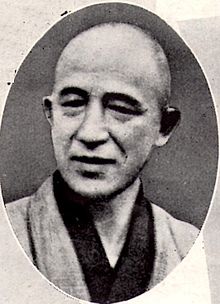Nishitani Keiji
Nishitani Keiji ( Japanese 西 谷 啓 治 ; * February 27, 1900 ; † November 24, 1990 ) was a Japanese philosopher . He is considered one of the most important philosophers in Japan in the 20th century.
Live and act
Nishitani Keiji was a student and successor of Nishida Kitarō , the founder of the Kyoto school .
In 1924 Nishitani received his doctorate on the ideal and the real under Schelling and Bergson . In the years 1937 to 1939 he stayed to study with Martin Heidegger in Freiburg im Breisgau and taught as a professor in Kyoto from 1943 .
Nishitani was a religious philosopher who combined experiences from the practice of Zen Buddhism with existentialism and with Martin Buber's anthropological approach. Thanks to his detailed knowledge of western and eastern philosophy, a parallel representation of nihilism and shunyata is possible , which can also be formulated in Christian theological language. His main work on the philosophy of religion, "Shūkyō-towa-nanika", has been published in German translation under the title "Was ist Religion?" (Frankfurt a. M. 1982). The German philosopher Heinrich Rombach judged in a review of the book: "This author's case is coherent and convincing. [...] It will probably be difficult to present a more authentic self-representation of the Asian idea, and also at the level of the highest speculation and the latest historical interpretation , to find."
Works
- Nishitani Keiji chosakushū (Collected Works of Nishitani Keiji). Sōbunsha, Tokyo 1986-1995.
- What is religion German translation authorized by the author by Dora Fischer-Barnicol. Insel-Verlag, Frankfurt am Main 1982.
- Religion and Nothingness . The University of California Press, Berkeley 1982, ISBN 0-520-04946-2 .
- The Self-Overcoming of Nihilism . State University of New York Press, Albany 1990
- The Japanese Art of Arranged Flowers . Translated by Jeff Shore. In: Robert C. Solomon, Kathleen M. Higgins (Eds.): World Philosophy: A Text with Readings . McGraw Hill, New York 1995.
literature
- Fred Dallmayr: Heidegger and Zen Buddhism: a Salute to Nishitani Keiji. In: The Other Heidegger. Cornell University Press, Ithaca / London 1993.
- Bret W. Davis: Shûkyô kara seiji e, seiji kara shûkyô e: Nishitani Keiji no tenkai (From religion to politics, from politics to religion: Nishitani's turn). In Fujita. 2003.
- Myriam-Sonja Hantke: Mysticism in German Idealism and in Japanese Philosophy: Schelling, Hegel, Nishitani . Verlag Traugott Bautz, Nordhausen 2009. ISBN 978-3-88309-468-7
- Johannes Ernst Seiffert: Way of Existence: to K. Nishitani: "What is religion?" in view of the similarities and differences between Heidegger's way of thinking and Zen. AIGN-Verlag, Kassel 2010, ISBN 978-3-931343-26-2 .
- Taitetsu Unno (Ed.): The Religious Philosophy of Nishitani Keiji. Asian Humanities Press, Berkeley 1989.
Web links
- Literature by and about Nishitani Keiji in the catalog of the German National Library
- Bret W. Davis: The Kyoto School. In: Edward N. Zalta (Ed.): Stanford Encyclopedia of Philosophy .
- Fred Dallmayr: Nothingness and 'Suuyataa': A Comparison of Heidegger and Nishitani , in Philosophy East and West, 42/1, 1992, pp. 37-48.
Single receipts
- ^ Letter from Hans A. Fischer-Barnicol to Martin Buber dated November 3, 1964, in: Martin Buber: Correspondence from seven decades. Volume III, Heidelberg 1975, pp. 623-626.
- ↑ Philosophisches Jahrbuch 91 (1984) 440.
| personal data | |
|---|---|
| SURNAME | Nishitani, Keiji |
| ALTERNATIVE NAMES | 西 谷 啓 治 (Japanese) |
| BRIEF DESCRIPTION | Japanese philosopher |
| DATE OF BIRTH | February 27, 1900 |
| DATE OF DEATH | November 24, 1990 |
